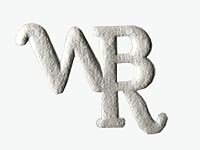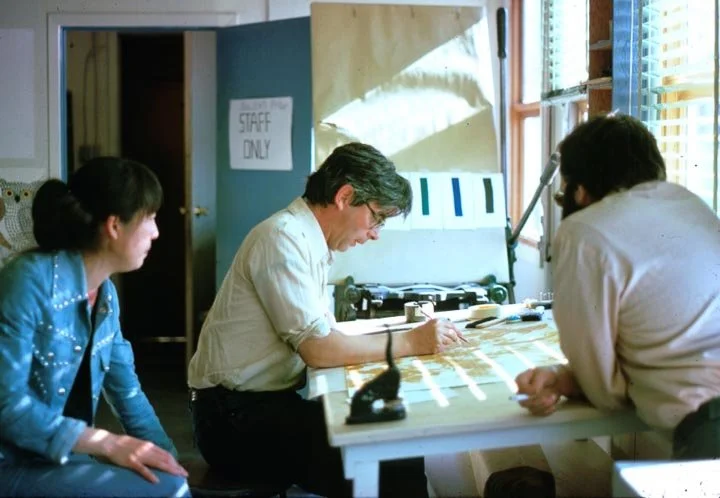Ouyagat Tetittogak (drawing on stone) A History of Kinngait Lithography
Terry Ryan. photo: Tessa Macintosh
In the 1973 print release catalog Terry Ryan briefly mentions the pending release of a lithograph collection.
“As for the young people, both teenagers and those in their twenties, they perhaps regretfully are not representing are not represented here. They are represented, however, in their roles as print makers in the yet to be released collection of lithographs, film makers of promise under a program being conducted by the National Film Board specializing in animation, silversmiths, weavers, and hopefully Typographers, from whom we have great expectations, based on experiments completed to date.”
— 1973 Cape Dorset Print Catalogue 1973
However, it wasn't until 1975 that the first lithographic prints were released. From the 1975 catalog:
“This year, for the first time, a collection of lithographs is being included in the annual collection, complementing the stone cuts, stencils, and copper engravings. It has been three years since the first attempts were made in this new medium....
Aside from working semi-precious stones, silver, bone and ivory, another promising undertaking is slowly coming to fruition in the recently completed letterpress workshop.”
Terry Ryan. photo: Tessa Macintosh
Lithography in Kinngait Studios
Lithography was a relatively late arrival to the Cape Dorset scene. It was encumbered by equipment and unlike the more direct technique of stone cut, a complex technical process. As a result, lithography was, and arguably still is, viewed as the red-headed stepchild of Inuit Art. I will try to illustrate the historical development of lithography in Dorset. Please let me know if I missed something or if you have something to contribute I will add it to this treatment.
“Printmakers at the West Baffin Eskimo Co-operative studio continued to expand their artistic horizons. In 1972 with the assistance of Lowell Jones, Robert Patterson, Charlie Pachter and Avrom Isaacs, Cape Dorset artists received their first lithography press and began to explore this new print technique.”
Lowell Jones worked in Cape Dorset from 1972-73:
“It was just like Lowell Jones to take up windsurfing in his 60's. The longtime Chico artist, who died of cancer November 22nd, at the age of 69, was an adventurous man who charted a zigzag course in life as he welcomed new experiences. For example, he took a leave of absence from his professorship at the University of Kentucky to work in the Canadian Arctic, where he was the first person ever to teach stone lithography to Inuit artists.”
http://www.legacy.com/obituaries/chicoer/obituary.aspx?n=lowell-jones&pid=2868301
http://www.newsreview.com/chico/remembering-lowell-jones/content?oid=32954
http://www.historymuseum.ca/capedorsetprints/history/1970s.php
the above is a good run down of the chronology.
Now Avrom Isaacs, or“Av” as he was fondly called, was a mover and a shaker in the Toronto art scene. His name is synonymous with Dorset and he continues to be a very close friend to Terry Ryan*. Av had two galleries, the Issac’s Gallery where he promoted bleeding edge southern artists and the Gallery Inuit where he showed work from the arctic. It would be an interesting project to research all that Av did in and with the arctic. His long reach was likely responsible, but not entirely, for the rich visiting artist program that flourished in Cape Dorset in the 70's. Wally Brennan had come to Dorset having been head hunted by Alma Huston and he had been involved in the Nova Scotia College of Art and Designs Custom Printshop, more of this later.
*https://en.wikipedia.org/wiki/Avrom_Isaacs, sadly Av died January 15 2016.
A list of those visiting artists and printers was assembled for Cape Dorset Prints: A Retrospective Fifty Years of Printmaking at the Kinngait Studios edited by Leslie Boyd Ryan (now Leslie Boyd). It reads like the who's who of artists and printers of the day. A lot of the visiting talent can be directly attributed to Terry Ryan’s belief that by exposing creative minds to other creative minds wonderful things would happen. To be sure, in the heady early days of seemingly endless Inuit talent and few budget constraints anything seemed possible. Many artists were seduced by the arctic's siren call. Most came and went, but a few came and stayed. While all left their mark(s), some argue that the latter were the most effective because their prolonged presence provided much needed continuity.
Wally far right sitting with Les Levine. (unknown woman far left).:photo: Tessa Macintosh
Wally showing Ian Murray lithographs.:photo: Tessa Macintosh
Terry Ryan explained to me that though Charlie Pachter did come to Cape Dorset it was for only a matter of days before he returned to a more southern hospitable world.
Robert (Bob) Paterson is reputed to have kept returning to Cape Dorset, visiting in 1964, 1973, 1985, and again in 1991. I never met Bob and he died March 19th, 2013 in Wa Wa, Ontario having lived his life making art.
Bob Paterson also know as Siqpik and Iqaluk Pingwartok holding the camera. Fabric, carvings stencil stone cuts,what energy, this room still exists today.
“Bob was born in Saskatchewan, but grew up in Sudbury. He has had a life- long love affair with art beginning with his attending the Ontario College of Art. After graduating, he worked with Inuit printmakers at Cape Dorset, and then taught at Georgian College before retiring in 1978 to devote himself to creating his own works of art. “
Wallie Brennan (centre), Pitseolak Niviaqsie (left) and Pee Mikkigak (right).:photo: Tessa Macintosh
There were lithography presses set up in Cape Dorset before Wallie Brennan arrived in 1974. Wallie was a Tamarind alumni like myself and Rob Harmer, another studio manager from 2000-2003. Wally stayed and lived in the community from 1974 until 1984 -a remarkable commitment to the project. He arrived with his wife (Tessa), photographer who is responsible for so many of the beautiful photographs of Dorset from the early 70’s.
Wally came from the professional print shop at the Nova Scotia College of Art and Design in Halifax where Bob (Robert) Rogers was the master printer (also Tamarind trained). When the professional shop closed down, Bob became the instructor of lithography and I studied with him during my time at NASCAD from 1974-76. As an aside I invited Bob to Cape Dorset in 1990 as a visiting printmaker/artist.
Wallie reorganized the Dorset studios, making them more ergonomic and professional. He also acquired the newer Charles Brand Presses that we still use today. We have the two Fuchs and Lang presses used by Wallie (see photo below) in storage here, in Dorset. I’d like to know where they came from if anyone knows.
Fuchs and Lang presses in storage. Note the Vandercook to the left before it was restored.
Wallie trained a core of lithographers, the lingering effect was Pitseolak Niviaqsie, a Master Printer whom I had the pleasure of working with for almost two decades. Pitseolak knew the process so well that there was nothing he wouldn’t try and had innovated many of the techniques evident in the many years of his service. He retired after a battle with cancer which he keeps at bay even to this day. (Sadly passed away since) He was a remarkably accomplished lithographic printer.
Pitseolak about to register a paper on a lithographic stone. :photo: Tessa Macintosh
Something I like to mention when I do tours for visitors through the studios is that the printers for the most part don't read English. I went to school for many years to learn lithography and I have every book ever written about the process. If I have a problem I can grab any book or binders full of notes but there are no books about lithography written in Inuktitut. The printers must either know the process or they must figure it out amongst themselves. All the materials that are used in lithography are imported, there is nothing from the arctic world that used in the process other than water and even that has to be modified now because of the high chlorine content added by the local Hamlet. Everything has to be given a name as well so that the printers can talk about the process and materials. When a senior printer dies or retires along with them goes their cumulative knowledge and the new young printers are left to learn as best they can. The arts advisor position is to provide a constant knowledge base for all the printers to act as a bridge from one era to the next. Fortunately most of the printers understand some English so we can communicate but some don't which means discussions about process or technique has to be done through a translator or interpreter which is very difficult at the best of times.
I met Wallie once, in Toronto at the gala celebration for “the book” about Cape Dorset Prints edited by Leslie Boyd. Leslie was very fond of Wallie and I think the feeling was mutual, as veterans are with a shared experience.
http://www.artmetropole.com/popups/events/events_07/94_wallace-brennan/wallace-brennan.html
“Visiting artists were also an influence on Inuit artists. In the mid-1970s Cape Dorset saw many southern print makers visit and some who stayed. Lithographer Wallace Brennan's arrival also had an effect on Pudlo Pudlat. While he didn't feel at ease in the printshop's setting, the process did teach Pudlo to work with an artwork's entire area and to "open up" his drawings.”
When I arrived in 1988, I could tell that despite the haphazard nature of supplies, the place was well outfitted and somebody knew how to set up a studio for production. Over the years I ran into old books, posters and correspondence between Wallie and suppliers. There used to be a few proofs of Wallie's lying around, unsigned and incomplete. You can read my positive thoughts on the "Wallie effect" with regards to nomenclature and chops under the heading of Chops.
Pitseolak explained through a translator that when Wallie ran the shops they printed everything! I guess he was comparing this to my cautious, fiscally responsible approach. Today, we only print select images with a healthy dose of proofing.
I initially came north under the auspices of being a visiting artist, but it soon became clear that Terry Ryan hoped I would devote my energy to sorting out the lithography studios. Lithographer Liz Parkinson had returned to Toronto in 1986. I came on the heels of an arctic-wide workshop headed up by Don Holman. Don is a master lithographer that worked out of Open Studio and has an infectious enthusiasm for the process of lithography and all that you can do with it. Don told Terry that he'd met me in Newfoundland at St. Michael’s Printshop, then on the Southern Shore, south of St.John’s. Don mentioned that Terry Ryan was interested in having me come north to check things out and in a few days I got “the call”.
I agreed to come up for three weeks to do my own work, which I did. Then, one night during dinner at Terry's house, I was offered the opportunity to extend my stay. I returned home to Newfoundland, packed my things and moved to Cape Dorset for the remainder of that season. As June rolled around, Terry asked me to come back again in September, so I did. The same thing happened the following year.
I spent three winters in Dorset but then decided to move on. First to the Banff Centre for the Arts and then to the Tamarind Institute in New Mexico. After about 5 years I heard from Terry again. I returned to Dorset to replace the outgoing lithography studio manager Rob Harmer (Tamarind trained as well). Rob had really shaped the shop into a professional space and introduced the photo process to plate lithography among other things. *Today, I'm the manager of Kinngait Studios and I spend about five months every year overseeing stone cut, drawing development and lithography.
*I retired from Kinnagit Studios in 2020.
http://www.historymuseum.ca/capedorsetprints/techniques/lithography.php
This page gives a brief overview of how lithography works







